1835  was
a tense year in northern Florida. Americans and the Seminole Indians had
already fought one war and now white settlers were again building farms on land claimed
by the Indians. Fearing further reprisals from the Seminoles, the army
decided to move them out to Oklahoma. With little experience in guerrilla warfare, the Army moved in and established several forts. On the morning of
December 23, 1835, two companies of soldiers, made up of 98 enlisted men and a
complement of officers, under the command of Major Francis Dade left Fort
Brooks (Tampa)
was
a tense year in northern Florida. Americans and the Seminole Indians had
already fought one war and now white settlers were again building farms on land claimed
by the Indians. Fearing further reprisals from the Seminoles, the army
decided to move them out to Oklahoma. With little experience in guerrilla warfare, the Army moved in and established several forts. On the morning of
December 23, 1835, two companies of soldiers, made up of 98 enlisted men and a
complement of officers, under the command of Major Francis Dade left Fort
Brooks (Tampa)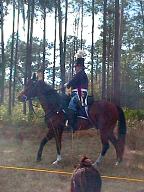 intending to march the 100 miles to Fort King. As is often the case in
history, exactly how, Osceola, the famed Indian
Chief of the Seminoles, learned about the reinforcements is not known.
However, some soldiers suspected Dade’s Negro scout, Louis Pacheco, may
have been working with the Seminoles. For the next 5 days, Indians
shadowed the column as it marched seemingly unaware of their predicament. This
condition became more evident as the hot tiring days dragged on. In
December, Major Dade, having passed most of the
best ambush points, demonstrated his confidence by
failing to order local security measures of any significance.
To guard against the cold weather, he allowed his men to button their coats over
their cartridge belts, a lazy habit, that would prove fatal. The
Indians s
intending to march the 100 miles to Fort King. As is often the case in
history, exactly how, Osceola, the famed Indian
Chief of the Seminoles, learned about the reinforcements is not known.
However, some soldiers suspected Dade’s Negro scout, Louis Pacheco, may
have been working with the Seminoles. For the next 5 days, Indians
shadowed the column as it marched seemingly unaware of their predicament. This
condition became more evident as the hot tiring days dragged on. In
December, Major Dade, having passed most of the
best ambush points, demonstrated his confidence by
failing to order local security measures of any significance.
To guard against the cold weather, he allowed his men to button their coats over
their cartridge belts, a lazy habit, that would prove fatal. The
Indians s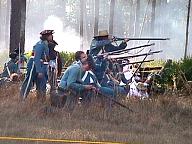 elected
an excellent ambush site on the west side of the road. To the immediate east
side of the road, lay a pond that prevented any escape from the killing zone.
Working in advance of the column's arrival, each Indian found a place of
concealment so effective that not a single one of the approximately 180 Indians
were detected in the cold rain that was falling. Around 8:00 in the
morning, a single shot rang out, signaling the start of the attack. Within
seconds most of the Indians who had plenty of time to pick their targets, fired
at almost point black range.
elected
an excellent ambush site on the west side of the road. To the immediate east
side of the road, lay a pond that prevented any escape from the killing zone.
Working in advance of the column's arrival, each Indian found a place of
concealment so effective that not a single one of the approximately 180 Indians
were detected in the cold rain that was falling. Around 8:00 in the
morning, a single shot rang out, signaling the start of the attack. Within
seconds most of the Indians who had plenty of time to pick their targets, fired
at almost point black range. 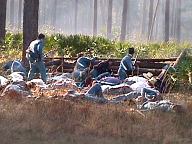 If Major Dade ever realized that his column
was under attack, no one noticed, as he was blown
from his horseback, dying instantly in the first volley, as was Captain Upton
Fraser, the second in command. As the smoke from that first volley
cleared, Captain George Gardiner found himself in charge, with 3 of his
remaining 6 officers wounded and over half of his men dead or dying around him.
As he returned fire and brought to bear the only 6 pound cannon he had, his men
desperately dragged downed trees and branches together to form
a makeshift breastwork. Under weathering
If Major Dade ever realized that his column
was under attack, no one noticed, as he was blown
from his horseback, dying instantly in the first volley, as was Captain Upton
Fraser, the second in command. As the smoke from that first volley
cleared, Captain George Gardiner found himself in charge, with 3 of his
remaining 6 officers wounded and over half of his men dead or dying around him.
As he returned fire and brought to bear the only 6 pound cannon he had, his men
desperately dragged downed trees and branches together to form
a makeshift breastwork. Under weathering 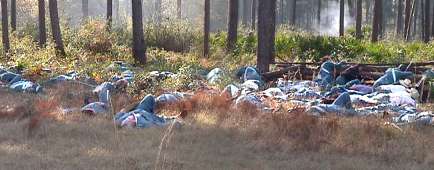 fire from shadows in the forest,
the remaining force gave a good account of itself, maintaining a continuous fire
even though there was nothing to be seen to fire at. The battle continued until
around 2:00 PM when the last rounds from the breastworks were fired. The now few
remaining survivors, out of ammunition, fell victim to a final charge as the
Indians overran their position with tomahawk and knife. No one was spared.
In the piles of bodies laying strewn
about were 3 survivors. Edwin DeCoursey, Joseph Sprague and Ransom Clark,
all
fire from shadows in the forest,
the remaining force gave a good account of itself, maintaining a continuous fire
even though there was nothing to be seen to fire at. The battle continued until
around 2:00 PM when the last rounds from the breastworks were fired. The now few
remaining survivors, out of ammunition, fell victim to a final charge as the
Indians overran their position with tomahawk and knife. No one was spared.
In the piles of bodies laying strewn
about were 3 survivors. Edwin DeCoursey, Joseph Sprague and Ransom Clark,
all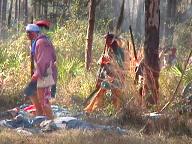 wounded, were overlooked and later escaped. Two of them completed the trek
to Fort Brooks. Louis Pacheco, the suspected collaborator with the
Seminoles miraculously survived and was captured by the Indians. The Seminoles
had lost 3 braves with 5 others wounded. They withdrew into the forest,
taking with them most of the equipment save the cannon which they pushed into a
nearby lake. Thus the second Seminole war began. It would become the
longest and most costly Indian war, America would ever fight. Seven years and
15,000 lives later, the last remaining Seminoles were captured and moved to
Oklahoma. Even as the war ended, several hundred remaining Indians slipped deep
into the swamps of southern Florida beyond the Army's ken.
wounded, were overlooked and later escaped. Two of them completed the trek
to Fort Brooks. Louis Pacheco, the suspected collaborator with the
Seminoles miraculously survived and was captured by the Indians. The Seminoles
had lost 3 braves with 5 others wounded. They withdrew into the forest,
taking with them most of the equipment save the cannon which they pushed into a
nearby lake. Thus the second Seminole war began. It would become the
longest and most costly Indian war, America would ever fight. Seven years and
15,000 lives later, the last remaining Seminoles were captured and moved to
Oklahoma. Even as the war ended, several hundred remaining Indians slipped deep
into the swamps of southern Florida beyond the Army's ken.
Now that was pretty exciting, not to mention loud and smoky, but what a way to learn a bit of American history. I rated this one right there up at the top, but then I'm a war buff.
*** THE END ***
